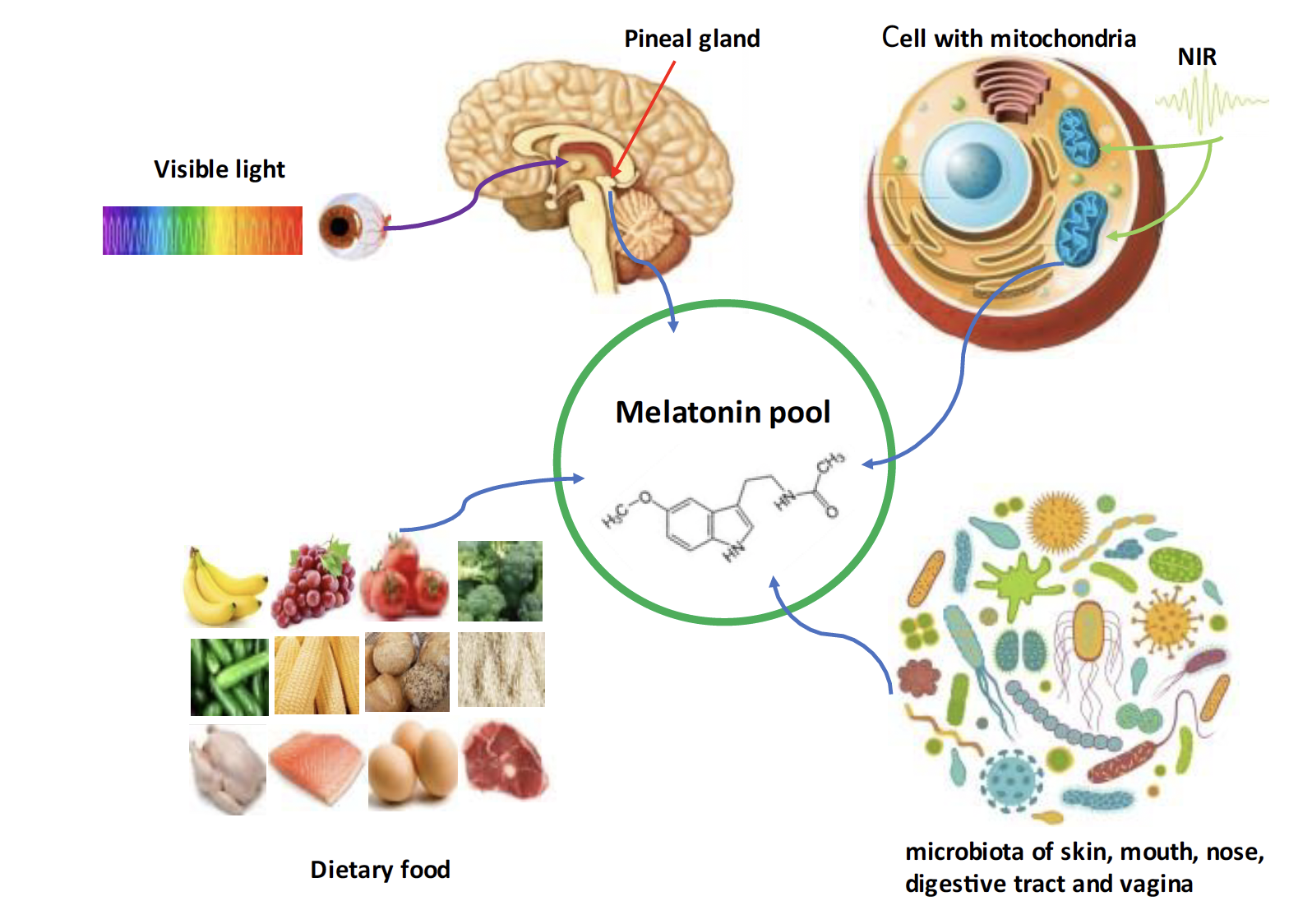Published on May 28, 2025
The latest research shines a new light on the complex relationship between melatonin, mitochondria, sunshine and our microbiome
Key Points
- Melatonin production is heavily influenced by exposure to light and exists in two main forms within the body – circulatory melatonin, which is produced by the pineal gland in response to blue light, and subcellular melatonin, which is produced in response to near infrared light and is used locally by the mitochondria within our cells
- Melatonin is now known to be a potent and unique antioxidant, with up to 10 times the antioxidant-fighting capacity as vitamin C
- Additional contributors to melatonin status include the microbes in our gut and on our skin, as well as some dietary sources
 Melatonin, well-known as the “sleep hormone,” has an extensive list of physiological actions that go well beyond sleep and circadian rhythm regulation. It is a potent antioxidant and a key player in mitochondrial function, metabolic balance, and chronic disease prevention. Its physiological actions include immune support, anti-cancer effects, blood pressure and glucose regulation, and strong anti-inflammatory properties.
Melatonin, well-known as the “sleep hormone,” has an extensive list of physiological actions that go well beyond sleep and circadian rhythm regulation. It is a potent antioxidant and a key player in mitochondrial function, metabolic balance, and chronic disease prevention. Its physiological actions include immune support, anti-cancer effects, blood pressure and glucose regulation, and strong anti-inflammatory properties.
In a nutshell, melatonin is a powerhouse antioxidant, a key immune system ally, and a molecule deeply tied to our daily exposure to light and dark. This relationship is illustrated in depth by a recent review by Tan et al.
Melatonin, Traditionally Known as “The Chemical Expression of Darkness”
Traditionally, melatonin has been nicknamed the “sleep hormone” or “the chemical expression of darkness.” Melatonin production, in this respect, is associated with the pineal gland which secretes melatonin in response to darkness. It then acts as a signaling molecule that regulates physiological adjustments in response to light and dark environments (day/night and seasonal changes). This pineal-derived melatonin is released into the bloodstream to help synchronize the body’s circadian rhythms through the light-controlled regulation of the brain’s master clock: the suprachiasmatic nucleus (SCN). Blue light from daylight (and artificial sources of blue light) suppresses pineal melatonin production, reinforcing the need for darkness at night. Due to the regulation of the SCN by light, levels of pineal-derived melatonin should be high at night and low during the day to support optimal sleep and circadian patterns.
New Research Shines Light on Additional Sources and Roles of Melatonin
Interestingly, pineal melatonin only accounts for about 5% of the body’s total melatonin production.

The diagram above illustrates several contributors to the ‘pool’ of melatonin in our bodies. The majority of melatonin is produced locally by the mitochondria within nearly all cells and tissues. Locally produced melatonin is not released into the bloodstream but is used on-site, providing critical protection to the cells where it is made (more below). Bacteria, archaea, and other microbes living in our gut and on our skin also have the ability to synthesize melatonin, indicating that our microbiome may be an additional source of melatonin. In fact, research suggests that microbial melatonin production benefits both the microbes themselves and their human host. Some melatonin can also come from food sources.
Melatonin: A Unique and Potent Antioxidant
Unlike classic antioxidants such as vitamin C, melatonin possesses exceptional capabilities in neutralizing damaging reactive species. This remarkable capacity makes melatonin a central figure in oxidative stress management. In fact,
“…one molecule of melatonin may scavenge up to 10 oxygen reactive species (ROS)/or nitrogen reactive species (NOS), whereas a classic antioxidant such as vitamin C only scavenges one or two of such reactants.”
Melatonin is also both water and fat soluble, allowing it to function in all areas of the cell, including membranes and intracellular spaces. Additionally, melatonin is produced several ways within our body, and its production is dependent on exposure to specific wavelengths of light and energy from sunlight.
The Sunshine-Mitochondria-Melatonin Connection
To activate your mitochondria to produce melatonin, you need exposure to sunlight, particularly Near Infrared (NIR) light—a part of the sunshine spectrum you can’t see, but your body feels. NIR, which constitutes a major portion of the solar spectrum, penetrates deeply into tissues and is essential for activating melatonin synthesis at the cellular level. It does so by engaging mitochondrial pathways involving cytochrome c oxidase, nitric oxide signaling, and soluble adenylyl cyclase. These pathways not only boost melatonin production but also support mitochondrial health, reduce oxidative stress, and enhance energy metabolism. According to Tan et al.,
“Daily exposure to sunlight likely boosts the brain’s antioxidant capacity by increasing melatonin production due to the deep penetration of NIR into the brain through the guide of CSF.”
Mitochondrial melatonin synthesis requires healthy mitochondria, meaning that mitochondrial dysfunction can compromise melatonin production and contribute to unwanted health effects. Diseases resulting from melatonin deficiency can include neurodegenerative disease, heart disease, metabolic disorders, osteoporosis and cancer.
Support Optimal Melatonin Production, Naturally
Modern lifestyles, marked by prolonged indoor living and excessive exposure to artificial blue light, disrupt our body’s natural production of melatonin. This may be a key driver behind the rise in chronic diseases linked to oxidative damage and mitochondrial dysfunction. The unfortunate reality is that many of us
- spend most of our days indoors under artificial lighting that lacks NIR
- overexpose ourselves to blue light from screens, which suppresses melatonin from the pineal gland, and
- don’t get enough natural sunlight, especially in the morning and evening when NIR is most available.
As a result, melatonin production suffers, and so does our health. To support natural melatonin levels:
- Get sunlight every day, especially morning and evening light for that valuable NIR
- Minimize blue light exposure after sunset
- Create dark sleeping environments
- Support your mitochondria through healthy movement, good nutrition, and stress management
Respect the power of sunlight for your health! Start incorporating regular sunshine exposure into your daily routine to increase your body’s production of melatonin, vitamin D, and other health-boosting chemicals.
Make Sure You Are Getting Enough of Both Sunshine & Vitamin D
It is important to incorporate safe, sensible sun exposure into a regular routine, just as it is important to make sure you are getting enough vitamin D. Because the sun produces many health-benefiting molecules in addition to vitamin D, sunshine exposure cannot be replaced with taking a supplement.
It is also important not to stop supplementing with vitamin D during the summer. Most people do not make enough vitamin D from sunshine alone, due to their lifestyle and other factors, and therefore must rely on supplementation to maintain optimal vitamin D levels of 40-60 ng/ml (100-150 nmol/L).
This Sunshine Month, get 10% off your home blood spot test kit plus get our Sunshine eBook for free when using the code SunMonth25 at checkout.
Are You Getting Enough Vitamin D from Sunshine?
 Having and maintaining healthy vitamin D levels and other nutrient levels can help improve your health now and for your future. Choose which additional nutrients to measure, such as your omega-3s and essential minerals including magnesium and zinc, by creating your custom home test kit today. Take steps to improve the status of each of these measurements to benefit your overall health. With measurement you can then determine how much is needed and steps to achieve your goals. You can also track your own intakes, symptoms and results to see what works best for YOU.
Having and maintaining healthy vitamin D levels and other nutrient levels can help improve your health now and for your future. Choose which additional nutrients to measure, such as your omega-3s and essential minerals including magnesium and zinc, by creating your custom home test kit today. Take steps to improve the status of each of these measurements to benefit your overall health. With measurement you can then determine how much is needed and steps to achieve your goals. You can also track your own intakes, symptoms and results to see what works best for YOU.
Enroll in D*action and Test Your Levels Today!






